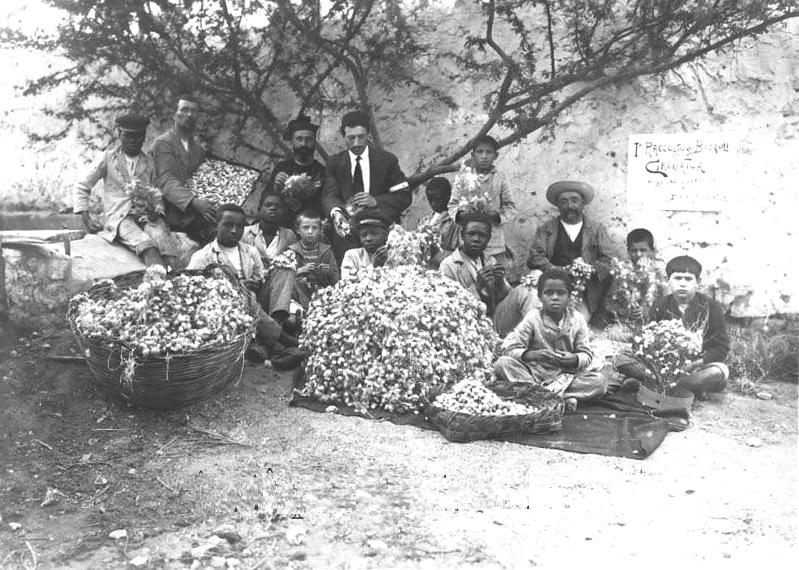
Libyan Economy

Figure 1.--One of the goals the Italians had in mind after seizing Libya from the Ottomans was to expand the agricultural sector. One of the crops they were interested in was cotton. The dealer suggests this photyograph was taken in 1915. Cotton is an important crop in neighboring Egypt, but at laeast in the Nile Valley, Egypt has more water than Libya.
|
|
The economy since ancient times has been agricultural. Libya was better watered in ancient times than today. The coastal area of Tripolitania was fertile. The Phoenicians and Greeks established coastal cities as trading posts with the interior (1000 BC). The powerful kingdom of the Garamentes was established in the Fezzan (southwestern interior) (500 BC-700 AD). They are related to modern Tuaregs. The Garamentes controlled the oases and the caravan trade. They oversaw some irrigation to promote agriculture. Rome acquired western Libya (Tripolitania) as a result of the Third Punic War (186 BC). Eastern Libya was peacefully acquired (96 BC). Libya was a prosperous Roman province. A golden age was described (2nd century AD). The city of Leptis Magna rivalled a rebuilt Carthage and Alexandria. The Emperoir Septimius Severus came from Libya and reprtedly fostered economic growth. For some four decades, Tripolitania and Cyrenaica were wealthy and prosperous Roman provinces. The population live in a cosmopolitan spciety and sghared a Roman identity, common language, and impressive legal system. North Africa was an important source of grain during the Roman era and Tripolitania was an important farmin area. The Arabs conquered Libya (642-44). The Ottomans after conquering Egypt seized the area (16th century). It was a very poor province as agriculture was declining and so mmuch of the country was desert. Dates, olives, and oranges were grown in coastal oasis. There was some economic activity as a result of Saharan caravans. Enslaved African captives were a primary caravan offering. Like the rest of the North African coast, Libya became a haven for pirates. The slave trade and piracy were the mainstay of the economy. The fledgling Uniuted States fought its first foreign war with the Barbary Pirates based in Tripoli and other nominally Ottoman provinces--the First Barbary War (1801-05). The economy continued to langulish under Ottoman rule. Italy invaded Lestablishing their authorithy ibya just before World Wat I (1911). They had trouble establishing control beyond the major coastal cities. Musollini launched a vicious pacification campaign after the War resorting to poispn gas (1920s). The Italians began an effort to improve infrastructure, brining in Italian settlerts and develo the economy. One effort was to expand the production of cotton. Libya was a World War II battle gtound (1940-43). Oil was discovred after the War (1957). Exporting oil became the country's primary economic activity, brining great wealth to an impoverishe country. For the first time since the Roman imperial era wealth was created from a domestically produved product.
Col. Gaddafi seized power (1969). He brought stability and a chaotic system to Libya. Like other Arab oil expoters, the oil wealth turned Libyans into consumers although only limited benefirs filtered down to the lower ranlks of society. And the oil money rather than help finance a modern economy, actually adversely affected much of the limited economic activity which existed before the discovery of oil. Gaddafi used much of yhe oil money to enrich chronies and to finance both military purchases and and terrorism. There was no real effort to develop a modern economy. The economy is almost entirely dependant on oil and gas exports. The Arab Spring brought down Gaddafi, but the country has since descened into chaos.
CIH

Navigate the Boys' Historical Clothing Web Site:
[Return to the Main Middle Eastern economies page]
[Return to the Main Libyan page]
[Return to the Main Libyan human rights page]
[Return to the Main Libyan Holocaust page]
[About Us]
[Introduction]
[Biographies]
[Chronology]
[Climatology]
[Clothing]
[Disease and Health]
[Economics]
[Freedom]
[Geography]
[History]
[Human Nature]
[Law]
[Nationalism]
[Presidents]
[Religion]
[Royalty]
[Science]
[Social Class]
[Bibliographies]
[Contributions]
[FAQs]
[Glossaries]
[Images]
[Links]
[Registration]
[Tools]
[Children in History Home]
Created: 3:09 PM 6/20/2019
Last updated: 3:09 PM 6/20/2019



